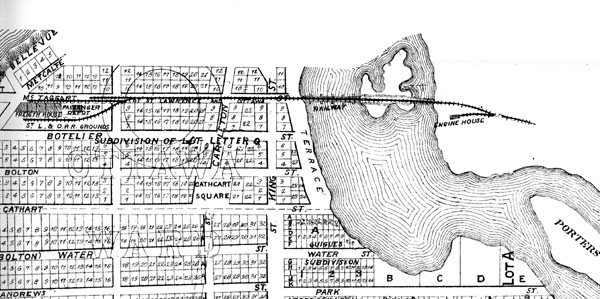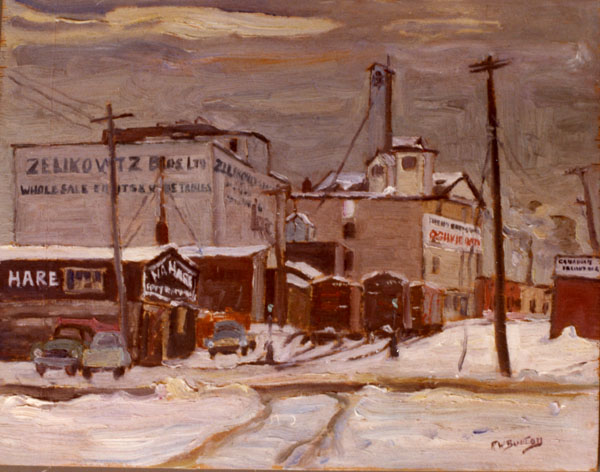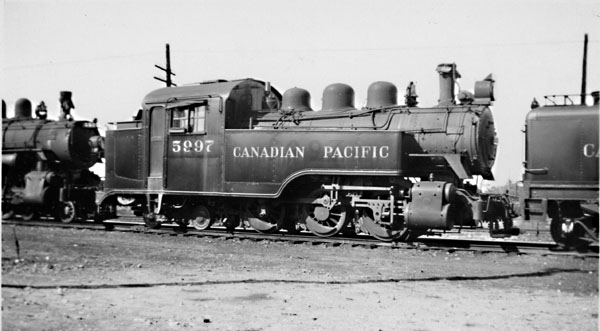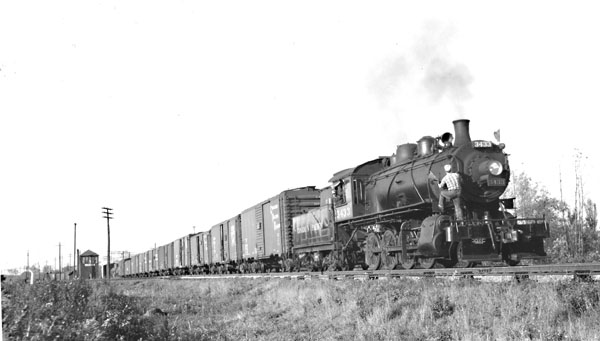|
The Sussex Street Station, Ottawa.
The Bytown and Prescott Railway Sussex Street,
or Lower Town, station, was the first station in Ottawa and remained the only
one for seventeen years. The station was on the west side of the Rideau
River just above the falls in the area now covered by the Lester B. Pearson
building of the Department of Foreign Affairs and International Trade.
Bytown Railway Society,
Branchline, December 2004.
An eastward looking aerial view of the Sussex Street station taken on 14th May 1928. The station area is to left of centre with Sussex Street running close to the Ottawa River in the foreground with the Notre Dame Basilica prominent on the right hand side. The bridges across the Rideau River can be seen together, just to the left, with the into Bridges which are still there today. The road crossing by the throat of the yard is Dalhousie Street and this side of it can be made out what appears to be the station building which replaced the original structure burnt in 1860. Part One – The Early years before the take over
of the Canadian Pacific
The station was opened with the opening of the line in late December 1854 or early January 1855 and railway service became an established part of the Ottawa life, although with a break of gauge at Prescott, travel to the outside world was not straightforward. On 7th May 1860 the station buildings caught fire. It was evident that any attempt to save the buildings would prove fruitless. The flames jumped to some nearby freight cars, and despite the efforts of the citizens to save them, four out of the fourteen were burnt before the train could be removed. The Station House and cars were filled with valuable merchandise, and the loss incurred was about $15,000. An inquest into the fire concluded, by a split vote, that the fire was caused by arson. The principal witness was the watchman at the depot. He testified that the fire originated in the store immediately adjoining the ticket office, in which he kept watch, and had a drunken friend sleeping at the time. In the store there were some fifteen leaky barrels of wine, and at least one barrel of camphene or burning fluid; and in making his usual rounds, the watchman had been in the store with a lantern some short time before to the fire was discovered. Some five or six minutes before to the outbreak, three men came on to and passed along the platform on which the stores and offices were situated, and passed the watchmen, walking at a rapid pace. He followed them for some seventy yards, and on his return, saw smoke issue from inside the store, his friend, the drunken man, being deeply asleep all the time. An explosion followed and his first priority was to save the books of the company, in which he was successful.[1] 
This shows the early layout of the Sussex Street station area, the bridge over the Rideau River and the roundhouse. (Historical Atlas of Carleton County 1879). One of the features of the station in the 19th century was the use made of it for regal and vice-regal occasions. It was convenient, not only because the line provided convenient access to Montreal via Prescott, but also because it was located close to Rideau Hall, the home of Governors General. When greeting a new Governor General, elaborate arrangements were made to decorate the station and surroundings to make the arrival a truly state occasion. These were quite frequent occurrences, (for example on 11th October 1862, 3rd May 1866, 11th October 1869, 24th January 1882). In 1866 upwards of five thousand spectators took peaceful possession of a considerable portion of the railway track adjoining the station, and swarmed on lines of empty freight cars, and roofs of adjacent buildings affording a view of the place of reception. The railway station and surroundings were decorated in a manner which reflected great credit upon the taste and public spirit of Mr. T. Reynolds, the popular and enterprising manager of the Ottawa and Prescott Railroad. The hand rail, enclosing the platform at the station, was decked with evergreens, relieved at intervals with strips of bunting, upon one of which, in red ink, shone conspicuously the loyal prayer - "God Save the Queen." Evergreens were also carried along the eaves of the station itself and round the ends in devices of pleasing effect. Each end of the Station was surmounted by a fine English flag. A handsome canopy was erected at the other end of the Station fronting the Ottawa, under which was a dais, ascended by two steps, whereupon was placed the chair of state to be occupied by His Excellency. The interior of the canopy was lined with scarlet cloth with which material the whole north end wall of the Station was covered. In the centre of the wall and behind the chair was hung a beautiful model of the Royal Arms worked in colored silk on a ground of rich texture. Above was suspended an elegantly framed portrait of Her Majesty. The platform facing this end of the station was covered with tapestry and scarlet cloth and the dais was also covered with the latter material. The handrail facing the above end of the station was hung with blue bunting on which the words "Queen Victoria" were displayed in white letters. The end of the freight station opposite was tastefully decorated with flags and flags, having in a conspicuous place, in red letters, on a white background, the good old English greeting "Welcome". Royal standards were carried on each side of the gable, in the figure of an arch corresponding to the form of the structure. Green boughs surmounted the whole. Then, in addition, gay colours streamed from the tops of the telegraph poles and all the houses within sight.[2] When His Royal Highness, Prince Arthur arrived in October 1869 a number of platform cars were on a siding, north of the railway and when the Prince and suite left the cars, the train was slowly backed out, so as to give those on the platform cars a full view of the reception and proceedings.[3] In May 1863 there was violence at the company’s down town offices which spilled over to the station. It arose during the shareholders meeting and service was interrupted for several days. All locomotives and cars were moved to the Prescott end of the line where they would be safe.[4] In 1867, the Ottawa and Prescott Railway was reorganized as the St. Lawrence and Ottawa Railway. There was a ceremony of a more somber type during the period of tension with the United States. On 15th March 1866 a guard of a sergeant and twelve men was detailed from the Bells Corners Infantry Company for sentry duty at the station. This lasted until the end of the month of March during which time the duties were shared with the St. Andrews Company and the Argenteuil Rangers.[5] In 1867 the city of Ottawa funded the construction of an emigrant shed at the station. This was 50 feet by 12 feet and was divided into four compartments 12 feet square. It was used as temporary accommodation by families new to Ottawa before they could find more permanent accommodation. This fell into disrepair and was eventually demolished in July 1888. [6] There were manoeuvres of a less than military type in December 1871. A man was shooting rats in the cellar with an old fashioned flintlock gun. The doctor said that there was a slight chance of saving a portion of his nose and one eye.[7] 1870 was a pivotal year for the Sussex Street station. In September the Canada Central Railway opened its broad gauge line to Carleton Place from a station in the Chaudiere district.[8] This broke the monopoly of the Ottawa and Prescott which had, by this time, become the St. Lawrence and Ottawa. In December 1871 the St. L. & O. completed a line from the original main line at Chaudiere Junction to the Chaudiere. [9] This is the route now used by the O Train. The Chaudiere line was built to tap the rapidly growing lumber mills in that region and a freight station and a roundhouse were also built. Passengers continued to be handled from Sussex Street except at those times when the line was closed as a result of flooding or closure of the Rideau River bridge. From 1871 onwards, gauge change cars were used to allow freight consignments to be shipped in one continuous movement without transshipment at Prescott.[10] This continued until the Grand Trunk converted to standard gauge on October 3-4, 1873. However, until this date passengers were forced to change trains at Prescott. One advantage of the Grand Trunk standard gauge was that Governors General could travel throughout in a special car. A double track shed was opened at Sussex Street in May 1879 to hold both the Governor General’s car the “Intercolonial” and the St. L. & O. directors car. By the 1880’s the station area was in a somewhat run down state. There was a large frog pond in the yard which was the delight of the local children who would sail rafts across it and conduct naval battles. It was a hang out for disreputable people and there were a number of spectacles such as dog fights.[11] It was not very pleasant for passengers in spite of the appointment of a policeman to try to keep order. The Times of Ottawa of 16th April 1867 summed up the situation admirably: “You may visit all the cities and towns from Quebec to London, C.W. and you will not observe such a crowd of vagabonds met at any corner for the express purpose of mobbing and otherwise abusing the passer by, as at the end of the platform of the Ottawa Railway Station. They amuse themselves by calling all manner of filthy names , and throwing missiles at every one passing by, and when a female passes alone, she is sometimes taken by the arm by one or two of them and conducted a distance on her way. Rideau River Bridge
Throughout the early period, the bridge over the
Rideau River was the achilles heel of the depot. Only four months after
opening to traffic the bridge was damaged by ice and the station was cut off
for about a week.[12] Every year in spring, the water levels and ice
action had to be carefully watched and there were numerous interruptions in
service.
A second wooden bridge was built over the winter of 1865-1866 in which the original three masonry piers were replaced. A pedestrian walkway was added on the side of the single rail track. This bridge was protected by icebreakers, which were not particularly effective, and the old bridge was removed before the spring run off in 1866.[13] A third wooden frame bridge was erected during the winter of 1874-1875 and was placed in service on 2nd April 1875. [14] Although there is no direct reference, a locomotive shed and turntable had to have been erected in Ottawa for the opening of the line in 1854-55. An engine house is shown in the Historical Atlas of Carleton County 1879 just to the east of the Rideau River bridge and south of the main line. The only direct references I have been able to find are: “The St. L. & O. R. have put in a new turn table at their round house here. It is much larger than the old one.” [15]It is likely that the turntable and engine facilities lasted only until the C.P.R. roundhouse was rebuilt at the Chaudiere around 1889. Part two – Control by Canadian Pacific
The Canadian Pacific Railway began to exercise influence in the affairs of the St. Lawrence and Ottawa as early as 1881 but a formal 999 year lease was not executed until 26th September 1884. Straight away, there were changes which had a significant impact upon Sussex Street. In January 1882 Canadian Pacific officials, including Van Horne, inspected the line[18] and indicated that there would be a switch away from Sussex Street to the Chaudiere where Canadian Pacific was in the process of integrating the former Canada Central line to Carleton Place and the former Quebec, Montreal, Ottawa and Occidental lines to Montreal and Aylmer. The first move placed more traffic through Sussex Street. On 5th September 1882 Canadian Pacific suspended service on the Chaudiere branch because the bridge over the Rideau River (not to be confused with the bridge over the Rideau River near Sussex Street) was unsafe. All traffic was handled through Sussex Street until October 1883.[19] The next blow to Sussex Street came on 24th August 1885 when the Prescott passenger trains were diverted to run to and from the Canadian Pacific Union station in the Chaudiere, reducing Sussex Street to freight only status.[20] There now began a run down of Sussex Street such that by the winter of 1887-1888 the line was blocked by snow for fully five months.[21] There appeared some sad descriptions: “Today the depot stands a deserted pile of ruinous sheds. Here the ruins of one destroyed by fire stands in all their black ugliness, there one blown by a gale lies a heap of worthless lumber, and utterly useless. The yard resembles a vast howling wilderness, with lines of rusty rails running between masses of rank weeds, whilst cars, passengers, hacks, locomotives and employees are all conspicuous by their absence, and the silence of Goldsmiths's deserted village reigns over the once busy scene. The only goods in the yard being a large pile of piles and an apparently dangerous quantity of petroleum.”[22] “The disused railway cars on the St. Lawrence & Ottawa railway north of the Rideau river, have been hacked up by disorderly characters who were in the habit of frequenting that locality at nights during the summer.” [23] The city of Ottawa placed pressure on Canadian Pacific to rebuild and reuse the Sussex Street yard and there was a good deal of posturing on both sides. The railway eventually agreed to reinstate the Sussex Street yard as a freight terminal but the Rideau River bridge would have to be rebuilt first.[24] The first train, a coal train, passed over the new bridge on 10th June 1889.[25] The passenger footbridge was not replaced and there was concern within the New Edinburgh community when C.P.R. prevented pedestrians from using the railway bridge.[26] In the end, an uneasy peace was arrived at with the railway bridge being used surreptitiously by the locals. The C.P.R. had already raised the track levels at the approach to the Rideau River bridge, this reduced the liability to flood during the spring but this was carried out mainly at the expense of the village of New Edinburgh at a cost of $2,500.[27] This work did not really solve the problem and the line was still susceptible to flooding. In November 1889 the C.P.R. brought the palace car “Victoria” round from the Chaudiere. This was kept, under daily supervision, in a special car shed for the private use of the Governor General. The car shed was near the Sussex Street entrance to the depot.[28] The C.P.R. quickly realized that the Lower Town depot was useful for inbound shipments of coal and there was a good trade in lumber from the mills which were located at the Rideau Falls close by. There was an unexpected twist in the fortunes of the station in 1898. The Ottawa and New York Railway was about to open its line from Cornwall to Ottawa and had been unable to reach an agreement with the Canada Atlantic Railway on running rights into and use of the Central Depot by the Canal Basin. An arrangement was hurriedly reached with Canadian Pacific and passenger, mixed and freight trains began to use the Sussex Street station on 29th July 1898.[29] One wonders what facilities were provided at a station which had last seen passengers thirteen years previously and on two or three days notice. Less than a week later, the station was used by what was probably its last VIP. On 5th September 1898 the Roman Catholic Archbishop of Ottawa, Archbishop Duhamel travelled on a special train as far as Embrun in order to bless the railway. [30] The Ottawa and New York used Sussex Street for passenger trains until 20th March 1899 [31] although, because the ice caused problems with the Rideau River bridge once more, a temporary station had to be used at the St. Patrick street bridge from 6th March 1899[32]. O. & N.Y. freight and mixed trains continued to use Sussex Street until 1st October 1901 when their own freight terminal was opened at Mann Avenue.[33] Evidently, the C.P.R. was still having trouble with the Rideau River bridge and a new bridge was constructed in 1900.[34] This time, four 96’ 10½” through steel truss spans were erected over the main channel and a 53” 10½” steel plate girder span over the secondary or eastern channel. In large measure, this work seems to have resolved most of the spring problems with the bridge as this lasted until the line was abandoned. 
By 1914 there was a need to expand the facilities and on 5th May the C.P.R. obtained permission to expropriate land on the north side of McTaggart Street for the enlargement of the terminal.[35] An industrial siding was built across Cumberland and Dalhousie Streets in 1915,[36] and in 1919 a siding was built across Dalhousie and Boteler Street to serve the Florence Paper Company.[37] Although not in the immediate Sussex Street area but providing additional revenue for the branch line, sidings were built to serve Dominion Bridge in 1911 and 1928,[38] and Baker and Betcherman in 1916 and 1917. [39] After cessation of passenger services and the concentration of facilities at the Chaudiere (Ottawa West), Sussex Street had been served by a switcher running out and back from Ottawa West, running one way tender first. In 1924[40] the diamond across the M. and O. subdivision at Hurdman was removed and this required a change in operation. The train would leave Ottawa West with the engine leading as normal and run via Chaudiere Junction. At Hurdman, the train would head out eastwards on to the M. and O. sub. and then back up (i.e. caboose leading) to Sussex Street. The train would return with the locomotive leading. At Hurdman, it would again head out eastwards on to the M. and O. sub. and would then back up towards Ottawa Union before running forwards on to the continuation of the Sussex Street sub. towards Chaudiere Junction and Ottawa West. 
Sussex Street continued to be busy through the Second World War and it was partly this success which spelt its downfall. The National Capital Commission wanted the line abandoned as part of the plan rid the area of industrial blight and to beautify the city and so this busy little terminal was forced to close and the customers had to relocate – at N.C.C. expense. At abandonment the following companies had premises at Sussex Street: In addition, the following companies had sidings on the Sussex Street subdivision north of Hurdman:Florence Paper Co siding All this came to an end on 15th June 1964[43] when Canadian Pacific abandoned the Sussex Street subdivision from Beechwood Avenue (m. 5.6) to the Sussex Street yard (m. 6.7). The last train ran through to Sussex Street on 12th June with locomotive 8469. On 15th June 1966 the line was abandoned between Beechwood Avenue (m. 5.6) and Hurdman (m. 3.5). [44]National Grocers 
2-8-0 No. 3433 returning from Sussex Street yard to Ottawa West in the vicinity of Hurdman tower. On reaching Hurdman it has run east on to the M&O and then backed across the M&O diamond with the CN, across the Rideau River and then come forward towards Ellwood, crossing the Alexandria sub. diamond. The brakeman is putting up green flags because today the train is running as the first section of train 95. From here it will run via Ellwood and the Prescott sub. to Ottawa West. 3433 was built in April 1910 as 1633 and was scrapped in June 1958. (Canada Science and Technology Museum, Mattingly collection. Matt-3806)The history of the first railway line into Ottawa is a complex one. The railway and its station played many varied roles in the development of Ottawa. Looking back over 150 years to the entry of the first trains into Ottawa it is difficult to imagine what impact this new technology would have on our city and I will close with a quote from the Bryson Equity of 24th July 1884, almost thirty years after the opening of the line: “Some days ago a brigade of canoes reached Rockcliffe under the direction of Mr. Whitman, a Hudson Bay trader. The Indians making up his party had never seen a locomotive before and when the train came into Rockcliffe they cheered and jumped wildly.”People still do this today when they see a steam locomotive! Footnotes
|